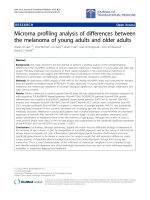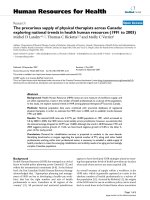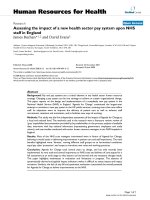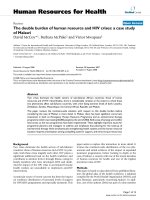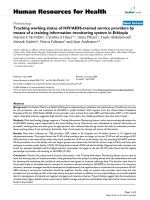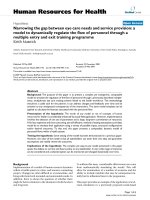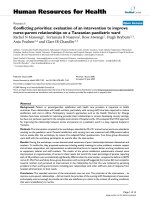Báo cáo sinh học: " Probability distribution analysis of M-QAM-modulated OFDM symbol and reconstruction of distorted data" pptx
Bạn đang xem bản rút gọn của tài liệu. Xem và tải ngay bản đầy đủ của tài liệu tại đây (506.69 KB, 20 trang )
This Provisional PDF corresponds to the article as it appeared upon acceptance. Fully formatted
PDF and full text (HTML) versions will be made available soon.
Probability distribution analysis of M-QAM-modulated OFDM symbol and
reconstruction of distorted data
EURASIP Journal on Advances in Signal Processing 2011,
2011:135 doi:10.1186/1687-6180-2011-135
Hyunseuk Yoo ()
Frederic Guilloud ()
Ramesh Pyndiah ()
ISSN 1687-6180
Article type Research
Submission date 10 March 2011
Acceptance date 19 December 2011
Publication date 19 December 2011
Article URL />This peer-reviewed article was published immediately upon acceptance. It can be downloaded,
printed and distributed freely for any purposes (see copyright notice below).
For information about publishing your research in EURASIP Journal on Advances in Signal
Processing go to
/>For information about other SpringerOpen publications go to
EURASIP Journal on Advances
in Signal Processing
© 2011 Yoo et al. ; licensee Springer.
This is an open access article distributed under the terms of the Creative Commons Attribution License ( />which permits unrestricted use, distribution, and reproduction in any medium, provided the original work is properly cited.
Probability distribution analysis of M-QAM-modulated
OFDM symbol and reconstruction of distorted data
Hyunseuk Yoo
∗
, Fr´ed´eric Guilloud and Ramesh Pyndiah
Department of Signal and Communications, Telecom Bretagne, Technopole Brest Iroise - CS 83818, 29238 Brest cedex 3, France
∗
Corresponding author:
Email addresses:
FG:
RP:
Email:
∗
Corresponding author
Abstract
It is usually assumed that N samples of the time domain orthogonal frequency division multiplexing (OFDM)
symbols have an identical Gaussian probability distribution (PD) in the real and imaginary parts. In this article,
we analyze the exact PD of M-QAM/OFDM symbols with N subcarriers. We show the general expression of
the characteristic function of the time domain samples of M-QAM/OFDM symbols. As an example, theoretical
discrete PD for both QPSK and 16-QAM cases is derived. The discrete nature of these distributions is used to
reconstruct the distorted OFDM symbols due to deliberate clipping or amplification close to saturation.
Simulation results show that the data reconstruction process can effectively lower the error floor level.
Keywords: OFDM; discrete probability distribution; M-QAM; nonlinear amplifier; data reconstruction.
1
1 Introduction
A significant drawback of orthogonal frequency division multiplexing (OFDM)-based systems is their high
peak-to-average power ratio (PAPR) at the transmitter, requiring the use of a highly linear amplifier which
leads to low power efficiency. For reasonable power efficiency, the OFDM signal power level should be close
to the nonlinear area of the amplifier, going through nonlinear distortions and degrading the error
performance.
The distortion can be introduced for two main reasons: nonlinear amplifier [1, 2] and/or deliberate
clipping [3]. For the first case, if an OFDM symbol is amplified in the saturation area of an amplifier, its
data recovery is not possible. For the second case, deliberate clipping makes an intentional noise which
falls both in-band and out-of-band. In-band distortion results in an error performance degradation, while
out-of-band radiation reduces spectral efficiency. Filtering methods can reduce out-of-band radiation, but
also introduces peak regrowth of OFDM signals and increases the overall system impulse response [4,5].
Several approaches have been investigated for mitigating the clipping noise with an amount of
computational complexity, such as iterative methods [6–10] and an oversampling method [11].
It is usually assumed that the time domain samples of OFDM symbols are complex Gaussian distributed,
which is a very good approximation if the number of subcarriers is large enough. Furthermore, it is
theoretically proved in [12,13] that a bandlimited uncoded OFDM symbol converges weakly to a Gaussian
random process as the number of subcarriers goes to infinity.
In this article, we derive the discrete Probability Distribution (PD) of the time domain samples of
M-QAM/OFDM symbols with a limited number of subcarriers. The discrete PD can be used to reconstruct
distorted OFDM symbols. We focus on the in-band distortion which can be caused when OFDM symbols
are amplified in the saturation area or when deliberate clipping is used to reduce the PAPR [3]. Note that
the conventional Gaussian assumption cannot be used for the data recovery of distorted OFDM symbols.
The article is organized as follows: In Section 2, we derive the PD of M-QAM modulated OFDM symbols.
Using our derivation of PD, we consider the data reconstruction (DRC) method in the presence of a soft
limiter in Section 3. Finally, we conclude this article in Section 4.
2 IDFT for M -QAM symbols
An OFDM signal in the time domain is the sum of N independent signals over sub-channels of equal
bandwidth 1/(T + T
cp
) and regularly spaced with frequency 1/(T + T
cp
), where T is the orthogonality
perio d and T
cp
is the duration of cyclic prefix.
2
At the transmitter, a frequency domain OFDM symbol X with N samples X = {X
0
, X
1
, . . . , X
N−1
} is
transformed via an N-point inverse discrete Fourier transform (IDFT) to a time domain OFDM symbol x
with N samples x = {x
0
, x
1
, . . . , x
N−1
}:
x
m
=
1
N
N−1
l=0
X
l
· exp
j
2πl m
N
, (1)
where m, l ∈ {0, 1, . . . , N −1}. Note that the transmitted signal is made of the time domain OFDM symbol
together with the cyclic prefix. Since the cyclic prefix is the copy of a part of x, the derivation of the
distribution of the samples in x completely determines the distribution of the transmitted signal.
We assume hereafter that all the frequency domain samples X
l
are uniformly distributed in the set of a
square M-QAM constellation S; for example: S = {
+1+j
√
2
,
+1−j
√
2
,
−1+j
√
2
,
−1−j
√
2
} in the QPSK case. In
addition, the real and imaginary parts of X
l
, denoted, respectively,
ˆ
X
l
{X
l
},
˘
X
l
{X
l
}, are
uniformly distributed as depicted in Figure 1. The minimum Euclidean distance of the constellation is
given by 2τ. Then, a general expression for the PD of {
ˆ
X
l
,
˘
X
l
}, l ∈ {0, 1, . . . , N − 1} is given by
Pr
ˆ
X
l
=
√
M − 2k −1
τ
= Pr
˘
X
l
=
√
M − 2k −1
τ
=
1
√
M
, (2)
where k ∈ {0, 1, . . . ,
√
M − 1}.
The characteristic function of
ˆ
X
l
and
˘
X
l
, l ∈ {0, 1, . . . , N − 1}, is given by [14]
ϕ
ˆ
X
l
(ω) = ϕ
˘
X
l
(ω)
E
exp
j
ˆ
X
l
ω
=
1
√
M
√
M−1
k=0
exp
j(
√
M − 2k −1)τ ω
, (3)
where E [·] is the expectation operator. We will use this characteristic function in order to obtain the PD of
time domain OFDM samples.
We first consider the real part ˆx
m
{x
m
} given by
ˆx
m
=
1
N
N−1
l=0
ˆ
X
l
· c(l, m) +
˘
X
l
· s(l, m)
, (4)
where c(l, m) cos
−2π lm
N
and s(l, m) sin
−2πlm
N
.
Given l and m, since both c(l, m) and s(l, m) are constants, the characteristic functions of
ˆ
X
l
· c(l, m) and
3
˘
X
l
· s(l, m) are obtained as
ϕ
ˆ
X
l
·c(l,m)
(ω) = ϕ
ˆ
X
l
(c(l, m) ·ω) =
1
√
M
√
M−1
k=0
exp
j(
√
M − 2k −1)τ ·c(l, m) ·ω
,
ϕ
˘
X
l
·s(l,m)
(ω) = ϕ
˘
X
l
(s(l, m) ·ω) =
1
√
M
√
M−1
k=0
exp
j(
√
M − 2k −1)τ ·s(l, m) ·ω
. (5)
Then, the characteristic function of
ˆ
X
l
· c(l, m) +
˘
X
l
· s(l, m) is given by
ϕ
ˆ
X
l
·c(l,m)+
˘
X
l
·s(l,m)
(ω)
=
4
M
sin
√
M
2
τ ·c(l, m)ω
cos
√
M
2
τ ·c(l, m)ω
sin(τ ·c(l, m)ω)
·
sin
√
M
2
τ ·s(l, m)ω
cos
√
M
2
τ ·s(l, m)ω
sin(τ ·s(l, m)ω)
(6)
which is proved in Appendix.
Since
ˆ
X
l
and
˘
X
l
, l ∈ {0, 1, . . . , N − 1}, are mutually independent, ϕ
N ˆx
m
(ω) is given by Equation (7).
ϕ
N ˆx
m
(ω) = ϕ
N −1
l=0
[
ˆ
X
l
·c(l,m)+
˘
X
l
·s(l,m)
]
(ω) =
N−1
l=0
4
M
sin
√
M
2
τ·c(l,m)ω
cos
√
M
2
τ·c(l,m)ω
sin(τ·c(l,m)ω)
·
sin
√
M
2
τ·s(l,m)ω
cos
√
M
2
τ·s(l,m)ω
sin(τ·s(l,m)ω)
. (7)
Therefore,
ϕ
ˆx
m
(ω) =
N−1
l=0
4
M
sin
√
M
2N
τ·c(l,m)ω
cos
√
M
2N
τ·c(l,m)ω
sin(τ·c(l,m)ω/N)
·
sin
√
M
2N
τ·s(l,m)ω
cos
√
M
2N
τ·s(l,m)ω
sin(τ·s(l,m)ω/N)
. (8)
The general PD for M-QAM modulated OFDM symbols can be obtained by using inversion of
characteristic function of (8), which is expressed as
Pr{ˆx
m
= x} =
1
2π
∞
−∞
ϕ
ˆx
m
(ω) exp(−jωx)dω. (9)
Notice that, since ϕ
ˆx
m
(ω) in (8) is a function of m, its PD is also a function of m. In other words, the
mathematical expression of PD in (9) has a large number of different forms, depending on m. In the
remainder of this article, to illustrate our reasoning, we restrict ourselves to the case where
m ∈ {0,
N
4
,
2N
4
,
3N
4
}.
When m ∈ {0,
N
4
,
2N
4
,
3N
4
}, Equation (8) is reduced to
ϕ
ˆx
m
(ω) =
2 sin
√
M
2N
τω
cos
√
M
2N
τω
√
M sin(τ ω/N)
N
=
sin(
√
Mτω/N)
√
M sin(τ ω/N)
N
. (10)
4
As a function of M, Equation (10) represents the characteristic function of ˆx
m
= {x
m
}. We proceed
further the PD derivation for two representative examples of modulation scheme: QPSK (M = 4) and
16-QAM (M = 16).
2.1 QPSK case
In the QPSK case (M = 4), Equation (10) turns into
ϕ
ˆx
m
(ω) = [cos(τω/N)]
N
=
1
2
N
N
N/2
+
2
2
N
N
2
−1
k=0
N
k
cos
(N − 2k)τ ω
N
,
=
1
2
N
N
N/2
+
1
2
N
N
2
−1
k=0
N
k
·
exp
j(N − 2k)τω
N
+ exp
−j(N − 2k)τω
N
. (11)
Referring to Equations (2) and (3), the discrete PD of ˆx
m
, Pr{ˆx
m
}, is given by
Pr{ˆx
m
= 0} =
1
2
N
N
N/ 2
,
Pr
ˆx
m
= τ
1 −
2k
N
= Pr
ˆx
m
= τ
2k
N
− 1
=
1
2
N
N
k
, (12)
where k ∈ {0, 1, . . . ,
N
2
− 1}.
Similarly, the PD of ˘x
m
{x
m
} can be derived as Pr{˘x
m
} = Pr{ˆx
m
}.
2.2 16-QAM case
In the 16-QAM case (M = 16), ϕ
ˆx
m
(ω) from (10) is given by
ϕ
ˆx
m
(ω) =
cos
2τω
N
N
·
cos
τω
N
N
=
2
cos
τω
N
3
− cos
τω
N
N
=
N
k=0
N
k
(−1)
k
· 2
N−k
·
cos
τω
N
3N−2k
, (13)
where
cos
τω
N
3N−2k
=
1
2
3N−2k
3N − 2k
3N−2k
2
+
1
2
3N−2k
3N −2k
2
−1
t=0
3N − 2k
t
·
exp
jτω(3N −2k − 2t)
N
+ exp
−jτω(3N −2k − 2t)
N
. (14)
5
Using (14), Equation (13) is expressed as follows:
ϕ
ˆx
m
(ω) =
N
k=0
N
k
·
3N − 2k
3N−2k
2
· (−1)
k
·
2
N
−
k
2
3N−2k
+
N
k=0
3N −2k
2
−1
t=0
N
k
·
3N − 2k
t
· (−1)
k
·
2
N−k
2
3N−2k
·
exp
jτω(3N −2k − 2t)
N
+ exp
−jτω(3N −2k − 2t)
N
. (15)
The first term in Equation (15) gives the PD of ˆx
m
:
Pr{ˆx
m
= 0} =
N
k=0
N
k
·
3N − 2k
3N−2k
2
· (−1)
k
·
2
N−k
2
3N−2k
. (16)
For the second term in Equation (15), let p = k + t, then
Pr
ˆx
m
=
τ(3N − 2p)
N
= Pr
ˆx
m
=
−τ(3N − 2p)
N
=
min(N,p)
k=0
N
k
·
3N − 2k
p −k
· (−1)
k
·
2
N−k
2
3N−2k
, (17)
where p ∈ {0, 1, . . . ,
3N
2
− 1}.
Similarly, we can obtain Pr{˘x
m
} = Pr{ˆx
m
}.
2.3 Graphical comparison
Figures 2 and 3 represent the comparison between the estimated (upper) and theoretical (lower) PDs of
{ˆx
m
, ˘x
m
} for the QPSK and the 16-QAM case, respectively, where m ∈ {0,
N
4
,
2N
4
,
3N
4
}. The estimated PD
matches the theoretical PD.
Note that these results describe the discrete distribution of {ˆx
m
, ˘x
m
}, which is not continuous Gaussian
distribution. In the following section, we will use the discrete nature of the distribution to reconstruct
distorted OFDM symbols.
3 Application to DRC
In this section, we show that PD analysis can be applicable to DRC at the receiver. We consider a
deliberately clipped OFDM symbol [3] or an OFDM symbol which operates in the saturation area of an
amplifier. Note that these kinds of distorted OFDM symbols yield an error floor, depending on the
saturation level.
6
3.1 Soft clipping
In order to illustrate the DRC concept, we consider hereafter an example of a QPSK case without loss of
generality. Figure 4 represents the constellation of X
l
(frequency domain), where l ∈ {0, 1, . . . , N − 1}.
Using Equation (12), the constellation of x
m
(time domain), m ∈ {0,
N
4
,
2N
4
,
3N
4
}, is depicted in Figure 5.
We assume that a soft limiter simply clips the OFDM symbol x
m
as follows [3]:
x
m
=
x
m
, for |x
m
| ≤ A
A ·
x
m
|x
m
|
, for |x
m
| > A,
(18)
where A is the maximum permissible amplitude limit, and m ∈ {0, 1, . . . , N − 1}. Note that A can be seen
as the saturated amplitude of the amplifier.
As the soft limiter is processed on x
m
, the clipping boundary can be observed on the constellation of x
m
as
depicted in Figure 6 for m ∈ {0,
N
4
,
2N
4
,
3N
4
}. In this figure, the circle represents the maximum permissible
amplitude (A = 0.24) as a clipping threshold. Therefore, the external constellation points (outside the
circle) are projected on the circle due to the clipping process. As a simple example, the constellation points
“” are projected on the circle and the points “” are transmitted instead of “”.
3.2 Data ReConstruction
Let s denotes the constellation of x
m
(see “♦” and “” in Figure 6), where m ∈ {0,
N
4
,
2N
4
,
3N
4
}. In this
example, the number of “♦” is n
d
= 21 and the number of “” is n
s
= 24. Therefore, the length of the
vector s is K = n
d
+ n
s
= 21 + 24 = 45 such as s = {s
1
, s
2
, . . . , s
45
}. The set s is divided into two subsets:
s
d
and s
s
s = {s
1
, s
2
, . . . , s
n
d
s
d
, s
n
d
+1
, s
n
d
+2
, . . . , s
K
s
s
}, (19)
where s
d
is the constellation inside the circle (“♦” in Figure 6) and s
s
is the constellation on the circle
(“” in Figure 6).
We consider two kinds of channel: noiseless and AWGN channels. Over a noiseless channel, if a received
sample r
m
= x
m
∈ s
d
, r
m
indicates one of “♦” marks. Then, DRC is not performed, since x
m
= x
m
. If a
received sample r
m
= x
m
∈ s
s
, r
m
indicates one of “” marks. Then DRC is performed by expanding this
“” mark to the expected position “” through the line as illustrated in Figure 7.
Over an AWGN channel, we can use maximum likelihood detection to reconstruct data. A priori
probability Pr{x
m
= s
k
}, k ∈ {1, 2, . . . , K} can be obtained from the joint probabilities of ˆx
m
and ˘x
m
,
m ∈ {0,
N
4
,
2N
4
,
3N
4
}, by using Equation (12). Through the AWGN channel, a noisy sample r
m
= x
m
+ w
m
7
is received, where w
m
is a complex Gaussian random variable with the AWGN standard deviation σ. Using
a maximum likelihood criterion, the most probable constellation symbol φ
m
∈ s is obtained as follows:
φ
m
= arg max
s
k
∈s
Pr{x
m
= s
k
} ·Pr{r
m
|x
m
= s
k
}
= arg max
s
k
∈s
Pr{x
m
= s
k
}
σ
√
π
exp
−
|r
m
− s
k
|
2
σ
2
. (20)
DRC is processed as follows: If φ
m
is positioned inside the circle (φ
m
∈ s
d
), r
m
is not modified. If φ
m
is
positioned on the circle, it means that φ
m
corresponds to a mark; then its corresponding mark is the
reconstructed value of r
m
.
3.3 Numerical results
Figure 8 shows the influence of DRC on the QPSK symbol error rate (SER). For the simulation,
QPSK/OFDM symbols are considered with N = 16. A soft limiter clips the OFDM symbol at
A = {0.22, 0.23, 0.24, 0.25}. In this figure, the dashed lines represent the original OFDM system (clipping
without DRC) and the solid lines represent the DRC case.
The figure shows that DRC can effectively lower the error floor in the presence of a soft limiter or a
saturated nonlinear amplifier, when N is small. Note that the performance improvements depend on the
clipping threshold A, since the constellation of {x
0
, x
N/4
, x
2N/4
, x
3N/4
} is fixed.
Regardless of the number of subcarriers N, the PD analysis is always valid, and is given by Equations (12),
(16), and (17). However, since only four subcarriers are used for DRC, the application for large N will be
less effective. Nevertheless, for higher values of N , it may be worth calculating Equation (9) for some more
values of m.
4 Conclusion
We analyze the PD of M-QAM-modulated OFDM symbols. Theoretically, the PD of the mth OFDM
symbol with N subcarriers is not continuous Gaussian, and the PD is a function of m, where
m ∈ {0, 1 . . . , N −1}. We provide a general form of the PD for m ∈ {0, 1 . . . , N −1}, and also derive the
PD for exemplary cases of m ∈ {0,
N
4
,
2N
4
,
3N
4
}. The discrete nature of the distribution can be used to
reconstruct the distorted OFDM symbols in the presence of a soft limiter or a saturated nonlinear
amplifier, by using the maximum likelihood criterion. The reconstruction of OFDM symbols lowers the
error floor level.
8
Appendix
Let C
1
τ ·c(l, m) · ω and C
2
τ ·s(l, m) · ω. Then, Equation (6) is expressed as
ϕ
ˆ
X
l
·c(l,m)+
˘
X
l
·s(l,m)
(ω)
=
1
M
√
M−1
k=0
exp
j(
√
M − 2k −1)C
1
·
√
M−1
k=0
exp
j(
√
M − 2k −1)C
2
. (21)
The first term in (21) is given by
√
M−1
k=0
exp
j(
√
M − 2k −1)C
1
=
√
M
2
−1
k=0
exp
j(
√
M − 2k −1)C
1
+
√
M−1
√
M
2
exp
j(
√
M − 2k −1)C
1
=
√
M
2
−1
k=0
cos
(
√
M − 2k −1)C
1
+ j sin
(
√
M − 2k −1)C
1
+
√
M
2
−1
k=0
cos
(
√
M − 2k −1)C
1
− j sin
(
√
M − 2k −1)C
1
= 2 ·
√
M
2
−1
k=0
cos
(
√
M − 2k −1)C
1
. (22)
In a similar way, the second term in (21) is given by
√
M−1
k=0
exp
j(
√
M − 2k −1)C
2
= 2 ·
√
M
2
−1
k=0
cos
(
√
M − 2k −1)C
2
. (23)
Then, using (22) and (23), Equation (21) is rewritten as
ϕ
ˆ
X
l
·c(l,m)+
˘
X
l
·s(l,m)
(ω)
=
4
M
√
M
2
−1
k=0
cos
(
√
M − 2k −1)C
1
·
√
M
2
−1
k=0
cos
(
√
M − 2k −1)C
2
=
4
M
√
M
2
−1
k=0
[cos ((2k + 1)C
1
)]
·
√
M
2
−1
k=0
[cos ((2k + 1)C
2
)]
. (24)
Using an arithmetic formula [15] denoting a finite sum of cosines given by
n
k=0
cos(ka + b) =
sin
n+1
2
a
cos
an
2
+ b
sin
a
2
, where n ∈ {1, 2, . . .}, (25)
9
Equation (24) is written as
ϕ
ˆ
X
l
·c(l,m)+
˘
X
l
·s(l,m)
(ω)
=
4
M
sin
√
M
2
C
1
cos
√
M
2
C
1
sin(C
1
)
·
sin
√
M
2
C
2
cos
√
M
2
C
2
sin(C
2
)
. (26)
Competing interests
The authors declare that they have no competing interests.
References
1. HG Ryu, JS Park, JS Park, Threshold IBO of HPA in the predistorted OFDM communication system. IEEE
Trans. Broadcast. 50(4), 425–428 (2004)
2. N Chen, GT Zhou, H Qian, Power efficiency improvements through peak-to-average power ratio reduction and
p ower amplifier linearization. EURASIP J. Adv. Signal Process. 2007, Article ID 20463, 7 (2007).
doi:10.1155/2007/20463
3. H Ochiai, H Imai, Performance of the deliberate clipping with adaptive symbol selection for strictly
band-limited OFDM systems. IEEE J. Sel. Areas Commun. 18, 2270–2277 (2000)
4. X Li, LJ Cimini, Effect of clipping and filtering on the performance of OFDM. IEEE Commun. Lett. 2, 131–133
(1998)
5. SH Han, JH Lee, An overview of peak-to-average power ratio reduction techniques for multicarrier
transmission. IEEE Wire. Commun. 12, 56–65 (2005)
6. D Kim, GL Stuber, Clipping noise mitigation for OFDM by decision aided reconstruction. IEEE Commun.
Lett. 3, 4–6 (1999)
7. H Chen, AM Haimovich, Iterative estimation and cancellation of clipping noise for OFDM signals. IEEE
Commun. Lett. 7(7), 305–307 (2003)
8. J Tong, L Ping, Z Zhang, B VK, Iterative Soft compensation for OFDM systems with clipping and
sup erposition coded modulation. IEEE Commun. Trans. 58(10), 2861–2870 (2010)
9. J Armstrong, Peak-to-average power reduction for OFDM by repeated clipping and frequency domain filtering.
Electron. Lett. 38, 246–247 (2002)
10. W Rave, P Zillmann, G Fettweis, Iterative correction and decoding of OFDM signals affected by clipping.
Multi-Carrier Spread Spectrum 6, 443–452 (2006)
11. H Saeedi, M Sharif, F Marvasti, Clipping noise cancellation in OFDM systems using oversampled signal
reconstruction. IEEE Commun. Lett. 6(2), 73–75 (2002)
12. S Wei, DL Goeckel, PA Kelly, A modern extreme value theory approach to calculating the distribution of the
p eak-to-average power ratio in OFDM systems, in IEEE ICC 2002, 2002
13. S Wei, DL Goeckel, PA Kelly, Convergence of the complex envelope of bandlimited OFDM signals. IEEE Trans.
Inf. Theory 56(10), 4893–4904 (2010)
14. Papoulis A, Pillai SU: Probability, Random Variables and Stochastic Processes, 4th edn. (McGraw-Hill, 2002)
15. GA Korn, TM Korn, Mathematical Handbook for Scientists and Engineers (Dover, 2000)
Figure 1. PD of the M -QAM symb ol. PD of the M-QAM modulated symbol in each real or
imaginary part,
ˆ
X or
˘
X.
10
Figure 2. PD of QPSK/OFDM symbol. Estimated (upper) and theoretical (lower) PD of {ˆx
m
, ˘x
m
} in
a time domain QPSK/OFDM symbol (N = 16), where m ∈ {0,
N
4
,
2N
4
,
3N
4
} and τ is normalized to τ =
1
√
2
.
Figure 3. PD of the 16-QAM/OFDM symbol. Estimated (upper) and theoretical (lower) PD of
{ˆx
m
, ˘x
m
} in a time domain 16-QAM/OFDM symbol (N = 16), where m ∈ {0,
N
4
,
2N
4
,
3N
4
} and τ is
normalized to τ =
1
√
10
.
Figure 4. Constellation of X
l
(QPSK modulation). Constellation of X
l
(QPSK modulation), where
l ∈ {0, 1, . . . , N − 1}.
Figure 5. Constellation of x
m
. Constellation of x
m
, where m ∈ {0,
N
4
,
2N
4
,
3N
4
}. Note that x
m
is the
mth sample of an OFDM symbol (time domain).
Figure 6. Illustration of clipping process (circle). Illustration of clipping process (circle). OFDM
symbols in Figure 5 are clipped at a given amplitude A = 0.24.
Figure 7. DRC. DRC from the clipped OFDM symbols “” to the original constellations “”.
Figure 8. QPSK SER with and without DRC. QPSK SER with and without DRC, where QPSK
modulated OFDM symbols (N = 16) are considered. A soft limiter clips the OFDM symbol at
A = {0.22, 0.23, 0.24, 0.25, ∞}. Note that the case of A = ∞ represents that OFDM symbols are not
clipped.
11
Probability
-3τ -1τ
-5τ
+1τ
+5τ
+3τ
ˆ
X or
˘
X
1
√
M
Figure 1
−0.8 −0.6 −0.4 −0.2 0 0.2 0.4 0.6 0.8
0
0.1
0.2
ˆx
m
or ˘x
m
Prob(analytical)
−0.8 −0.6 −0.4 −0.2 0 0.2 0.4 0.6 0.8
0
0.1
0.2
ˆx
m
or ˘x
m
Prob(simulation)
Figure 2
−0.8 −0.6 −0.4 −0.2 0 0.2 0.4 0.6 0.8
0
0.05
0.1
ˆx
m
or ˘x
m
Prob(simulation)
−0.8 −0.6 −0.4 −0.2 0 0.2 0.4 0.6 0.8
0
0.05
0.1
ˆx
m
or ˘x
m
Prob(analytical)
Figure 3
−1 −0.8 −0.6 −0.4 −0.2 0 0.2 0.4 0.6 0.8 1
−1
−0.8
−0.6
−0.4
−0.2
0
0.2
0.4
0.6
0.8
1
ℜ{X
l
}
ℑ{X
l
}
Figure 4
−0.4 −0.3 −0.2 −0.1 0 0.1 0.2 0.3 0.4
−0.4
−0.3
−0.2
−0.1
0
0.1
0.2
0.3
0.4
ℜ{x
m
}
ℑ{x
m
}
−0.4 −0.3 −0.2 −0.1 0 0.1 0.2 0.3 0.4
0
0.1
0.2
ℜ{x
m
}
Prob
−0.4
−0.3
−0.2
−0.1
0
0.1
0.2
0.3
0.4
0 0.1 0.2
ℑ{x
m
}
Prob
Figure 5
−0.4 −0.3 −0.2 −0.1 0 0.1 0.2 0.3 0.4
−0.4
−0.3
−0.2
−0.1
0
0.1
0.2
0.3
0.4
ℜ{x
m
}
ℑ{x
m
}
−0.4 −0.3 −0.2 −0.1 0 0.1 0.2 0.3 0.4
0
0.1
0.2
ℜ{x
m
}
Prob
−0.4
−0.3
−0.2
−0.1
0
0.1
0.2
0.3
0.4
0 0.1 0.2
ℑ{x
m
}
Prob
Figure 6
−0.4 −0.3 −0.2 −0.1 0 0.1 0.2 0.3 0.4
−0.4
−0.3
−0.2
−0.1
0
0.1
0.2
0.3
0.4
ℜ{x
m
}
ℑ{x
m
}
Figure 7
0 5 10 15 20 25 30 35 40
10
−8
10
−7
10
−6
10
−5
10
−4
10
−3
10
−2
10
−1
10
0
E
b
/N
0
(dB)
QPSK Symbol Error Rate
A = 0.22, DRC
A = 0.22, Original
A = 0.23, DRC
A = 0.23, Original
A = 0.24, DRC
A = 0.24, Original
A = 0.25, DRC
A = 0.25, Original
A = ∞, no clipping
Figure 8

